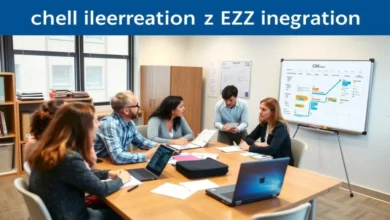Bridging the Digital Divide: Hybrid Offline-Online E-Learning Platforms for Remote Areas

In remote regions across the globe, limited infrastructure creates significant barriers to digital education. Traditional online learning platforms require consistent internet connectivity—a luxury unavailable to millions of potential learners. Hybrid offline-online e-learning platforms offer a revolutionary solution, enabling education to reach the most isolated communities without requiring constant connectivity. These innovative systems combine the best of both worlds: the rich, interactive experience of digital learning with the practicality of offline access.

Challenges of Digital Education in Low-Infrastructure Areas
Remote and rural regions face unique obstacles that make traditional online education nearly impossible to implement effectively. Understanding these challenges is crucial for developing appropriate solutions that can truly bridge the educational divide.
Connectivity Issues
In many remote areas, internet connectivity is either completely absent, prohibitively expensive, or highly unreliable. When available, connections often suffer from high latency and limited bandwidth, making real-time video streaming and large file downloads impractical. Weather conditions can further disrupt already fragile connections, leading to inconsistent learning experiences.
Infrastructure Limitations
Beyond internet connectivity, many remote regions struggle with unreliable electricity supply. Power outages can last hours or even days, rendering purely online systems unusable. Additionally, the cost of hardware and maintenance presents significant barriers, especially in economically disadvantaged communities where educational budgets are already stretched thin.
Digital Literacy Gaps
Both students and teachers in remote areas often have limited exposure to digital technologies. This creates a steep learning curve when implementing e-learning solutions. Cultural and language barriers can further complicate adoption, especially when platforms aren’t designed with local contexts in mind. These factors can lead to resistance or ineffective use of digital learning tools.

Facing These Challenges in Your Region?
Our team has helped governments and NGOs implement effective educational solutions in some of the world’s most challenging environments. Let us assess your specific situation and recommend appropriate approaches.Request Free Consultation
Technical Architecture of Hybrid Offline-Online E-Learning Systems
Hybrid e-learning platforms employ sophisticated technical architectures designed specifically to function in low-connectivity environments. These systems prioritize offline access while maintaining the ability to synchronize and update when connectivity becomes available.
Offline-First Design Principles
The foundation of effective hybrid platforms is an offline-first approach to design and functionality. Unlike traditional online systems that degrade when connectivity is lost, offline-first platforms are built with the assumption that users will primarily operate without internet access. All essential learning materials, activities, and assessments are stored locally on devices, ensuring uninterrupted access regardless of connectivity status.

Content Synchronization Workflow

Cloud Synchronization Mechanisms
When connectivity becomes available, hybrid platforms employ intelligent synchronization protocols to efficiently update content and upload user data. These systems prioritize critical data transfers, using bandwidth-aware algorithms that can adapt to varying connection qualities. Differential synchronization ensures only changed data is transferred, minimizing bandwidth requirements and making the most of limited connectivity windows.
Low-Bandwidth Optimization Techniques
To function effectively in bandwidth-constrained environments, hybrid platforms implement numerous optimization strategies. Content is heavily compressed and packaged for efficient transfer, with media assets available in multiple resolutions to adapt to connection quality. Progressive loading techniques allow users to access essential content first, while background processes handle larger, non-critical assets when bandwidth permits.
| Feature | Traditional Online Platforms | Hybrid Offline-Online Platforms |
| Connectivity Requirement | Continuous high-speed connection | Intermittent, low-bandwidth sufficient |
| Data Usage | High (streaming video, real-time interactions) | Low (compressed packages, selective sync) |
| Latency Tolerance | Low (affects real-time activities) | High (most activities function offline) |
| Infrastructure Needs | Reliable electricity, internet, modern devices | Minimal (can operate on basic devices, solar power) |
| Content Updates | Real-time, continuous | Periodic, batched during connectivity windows |
| User Data Collection | Continuous tracking and analytics | Stored locally, synced when possible |
Get the Complete Technical Implementation Guide
Our comprehensive guide provides detailed technical specifications, architecture blueprints, and implementation steps for building hybrid offline-online e-learning platforms in challenging environments.Download Free Guide
Case Studies: Successful Hybrid E-Learning Implementations
Examining real-world implementations provides valuable insights into how hybrid offline-online platforms can be successfully deployed in diverse contexts. These case studies highlight innovative approaches to overcoming specific challenges in remote areas.
Indonesia’s “Ruang Kelas Digital” Program
Spanning over 17,000 islands, Indonesia faces unique challenges in providing consistent education across its archipelago. The “Ruang Kelas Digital” (Digital Classroom) program was launched in 2019 to address these challenges, focusing on remote islands and mountainous regions with limited connectivity.
The program deployed a network of local servers in community centers and schools, each preloaded with the national curriculum and supplementary materials. These servers function as local content hubs, allowing students to access materials without internet connectivity. When internet becomes available, usually once weekly, the servers synchronize with central databases to update content and upload student progress data.
Key outcomes include:
- Reached over 500 previously underserved communities
- Increased student engagement by 43% compared to traditional methods
- Reduced educational material costs by 67%
- Improved standardized test scores by 28% in participating regions

Colombia’s “Aulas Sin Fronteras”

Colombia’s mountainous terrain and ongoing infrastructure challenges have historically limited educational access in rural regions. The “Aulas Sin Fronteras” (Classrooms Without Borders) initiative takes an innovative approach by combining mobile learning centers with hybrid technology.
The program utilizes converted buses equipped with solar panels, satellite connectivity, and a local server. These mobile units travel between remote villages on a regular schedule, allowing students to download new learning materials and upload completed assignments. Between visits, students continue learning offline using tablets preloaded with interactive content.
Notable achievements include:
- Serves 230+ communities in previously unreachable areas
- Reduced school dropout rates by 35% in participating regions
- Operates effectively despite average internet availability of only 8 hours per week
- Successfully integrated indigenous knowledge and languages into digital curriculum
India’s “Digital Sakshar” Initiative
India’s vast rural expanses present significant challenges for educational access. The “Digital Sakshar” initiative addresses these challenges through a community-centered approach to hybrid learning. The program establishes village knowledge centers equipped with solar-powered servers and tablets that operate independently of the power grid.
What makes this implementation unique is its focus on community ownership. Local facilitators are trained to manage the technology and support learners, creating sustainable educational ecosystems. The platform incorporates multilingual content and vocational training alongside academic subjects, addressing the diverse needs of rural communities.
Significant impacts include:
- Established 1,200+ knowledge centers serving 3 million+ learners
- Achieved 92% content availability despite average connectivity of only 3-4 hours daily
- Demonstrated 40% improvement in digital literacy among adult participants
- Created 3,600+ local employment opportunities through facilitator roles

Cost-Benefit Analysis: Hybrid vs. Traditional Online Solutions
When evaluating educational technology for remote areas, decision-makers must consider both immediate costs and long-term benefits. Hybrid offline-online platforms often present a more favorable cost-benefit ratio compared to traditional online-only solutions, particularly in challenging environments.

Initial Implementation Costs
Hybrid Platforms
- Lower bandwidth infrastructure requirements
- Can utilize existing or lower-cost devices
- Phased implementation possible
- Reduced dependency on constant connectivity
Online-Only Platforms
- Requires significant connectivity infrastructure
- Higher-spec devices often needed
- All-at-once implementation typically required
- Continuous high-bandwidth connectivity costs
Ongoing Operational Expenses
Hybrid Platforms
- Reduced bandwidth costs (60-80% savings)
- Lower power consumption requirements
- Decreased technical support needs
- Extended device lifespan due to offline operation
Online-Only Platforms
- Continuous connectivity expenses
- Higher electricity consumption
- More frequent technical support required
- Faster device replacement cycles
Long-Term Educational Impact
Beyond direct financial considerations, hybrid platforms deliver superior educational outcomes in remote settings. Studies across multiple implementations show that hybrid approaches typically result in:
- Higher completion rates: 35-45% improvement compared to online-only solutions in low-connectivity areas
- Better knowledge retention: Students show 28% higher retention rates due to consistent access to materials
- Increased digital literacy: Communities demonstrate broader technology adoption beyond educational applications
- Greater educational equity: Reduced performance gaps between urban and rural students
“The return on investment for hybrid e-learning platforms in remote areas is not merely financial. The true value lies in creating educational continuity where it was previously impossible, opening pathways to opportunity for millions of learners.”
— UNESCO Report on Digital Learning in Challenging Environments, 2023
Implementation Guide: Actionable Steps for Governments and NGOs
Successfully deploying hybrid offline-online e-learning platforms requires careful planning and execution. The following framework provides a structured approach for governments, educational institutions, and non-governmental organizations.

Phase 1: Assessment and Planning
- Conduct a comprehensive needs assessment
Map existing infrastructure, identify connectivity patterns, evaluate current educational resources, and assess digital literacy levels among both students and teachers. - Define clear educational objectives
Establish specific learning goals, curriculum requirements, and desired outcomes that align with national education standards while addressing local needs. - Secure stakeholder engagement
Involve community leaders, teachers, parents, and students in the planning process to ensure cultural relevance and build local ownership of the initiative. - Develop a phased implementation strategy
Create a realistic timeline with clearly defined milestones, starting with pilot programs before scaling to broader deployment.
Phase 2: Technical Infrastructure Development
- Select appropriate hardware solutions
Choose devices and local servers that balance performance requirements with durability, power efficiency, and cost-effectiveness. - Establish connectivity solutions
Implement the most suitable connectivity options for each location, which may include satellite, mobile networks, mesh networks, or scheduled connectivity visits. - Deploy local content servers
Install and configure local servers that can store educational content and serve as synchronization points when connectivity is available. - Implement power solutions
Develop reliable power systems, often incorporating solar or other renewable energy sources, to ensure consistent operation of educational technology.
Phase 3: Content Development and Adaptation
- Curate and develop appropriate content
Select, adapt, or create educational materials that align with curriculum requirements while being culturally relevant and engaging. - Optimize content for offline use
Format materials to minimize storage requirements while maintaining educational value, with special attention to interactive elements that function without connectivity. - Incorporate local languages and contexts
Ensure content is available in relevant languages and reflects local contexts, examples, and cultural references. - Develop assessment mechanisms
Create evaluation tools that function offline while generating data that can be synchronized and analyzed when connectivity is available.
Is Your Region Ready for Hybrid E-Learning?
What percentage of your target educational facilities have at least intermittent internet access?
- Less than 25%: Consider starting with completely offline solutions with periodic manual updates
- 25-50%: Hybrid systems with weekly synchronization windows are likely appropriate
- 50-75%: Standard hybrid platforms with optimized synchronization protocols
- Over 75%: Enhanced hybrid systems with more frequent synchronization
What is the typical duration of power availability in your target regions?
- Less than 8 hours: Prioritize low-power devices and solar charging solutions
- 8-16 hours: Standard battery-backed systems with power management
- 16-24 hours: Regular devices with basic power backup
- Unreliable but variable: Implement adaptive power management systems
What is the current level of digital literacy among teachers in your region?
- Very limited: Allocate 40-50% of initial budget to training and support
- Basic familiarity: Comprehensive training program with ongoing support
- Moderate proficiency: Targeted training on platform-specific features
- High proficiency: Focus on advanced features and content creation
Phase 4: Capacity Building and Training
- Develop comprehensive training programs
Create training materials and workshops for teachers, administrators, and technical support staff that address both technical and pedagogical aspects of the platform. - Establish local technical support capacity
Train local community members to provide first-level technical support, troubleshooting, and basic maintenance. - Create teacher communities of practice
Facilitate networks where educators can share experiences, strategies, and resources for effective hybrid teaching. - Implement cascading training models
Train master trainers who can then train others, creating a sustainable knowledge transfer system that reduces dependency on external experts.

Phase 5: Deployment and Scaling
- Launch pilot programs
Begin with carefully selected pilot sites that represent the range of conditions in your target regions. - Gather and incorporate feedback
Establish mechanisms to collect user experiences and technical performance data to inform improvements. - Refine the implementation model
Adjust technical specifications, content, and training approaches based on pilot results before broader deployment. - Develop a sustainable scaling strategy
Create a clear plan for expanding the program that addresses logistics, funding, and capacity building needs.
Phase 6: Monitoring, Evaluation, and Sustainability
- Implement comprehensive monitoring systems
Establish metrics and data collection processes to track educational outcomes, technical performance, and user engagement. - Conduct regular evaluations
Schedule periodic assessments to measure impact against established objectives and identify areas for improvement. - Develop sustainable funding models
Explore public-private partnerships, community contribution systems, and operational efficiencies to ensure long-term financial sustainability. - Plan for technology refresh cycles
Establish protocols for maintaining, updating, and eventually replacing hardware and software components.
Ready to Implement a Hybrid E-Learning Solution?
Our team of experts specializes in designing and implementing hybrid offline-online e-learning platforms for challenging environments. We offer comprehensive support from initial assessment through full deployment.Schedule a Strategy Session
Conclusion: The Future of Education in Remote Areas
Hybrid offline-online e-learning platforms represent a transformative approach to educational access in remote and underserved regions. By combining the advantages of digital learning with practical solutions for connectivity challenges, these systems can effectively bridge the digital divide and democratize quality education.
The success stories from Indonesia, Colombia, India, and other regions demonstrate that with thoughtful implementation, hybrid platforms can overcome seemingly insurmountable infrastructure limitations. These implementations not only provide immediate educational benefits but also contribute to broader community development by building digital literacy, creating local employment opportunities, and establishing technological foundations for future growth.
As technology continues to evolve, hybrid platforms will become increasingly sophisticated, offering richer learning experiences while maintaining their fundamental advantage of offline functionality. The integration of artificial intelligence for personalized learning, expanded multimedia capabilities, and improved synchronization mechanisms will further enhance their effectiveness in remote settings.
For governments, NGOs, and educational institutions committed to educational equity, hybrid offline-online e-learning platforms offer a practical, cost-effective path forward. By following the implementation framework outlined in this article and learning from existing success stories, organizations can develop sustainable solutions that truly meet the needs of learners in the world’s most challenging environments.

Take the First Step Toward Educational Transformation
Whether you’re a government official, NGO leader, or education administrator, we can help you assess your region’s readiness for hybrid e-learning and develop a customized implementation plan.Your Name*Organization*Email*Region/Country*Your Biggest ChallengeRequest Free Assessment
- live draw hk
- DINARTOGEL
- WAYANTOGEL
- DISINITOTO
- SUZUYATOGEL
- PINJAM100
- SUZUYATOGEL DAFTAR
- DEWETOTO
- GEDETOGEL
- slot gacor
- Paito hk lotto
- HondaGG
- PINJAM100
- DINARTOGEL
- DINARTOGEL
- PINJAM100
- PINJAM100
- PINJAM100
- PINJAM100
- PINJAM100
- HondaGG
- DWITOGEL
- bandar togel online
- situs bandar toto
- daftarpinjam100
- loginpinjam100
- linkpinjam100
- slotpinjam100
- pinjam100home
- pinjam100slot
- pinjam100alternatif
- pinjam100daftar
- pinjam100login
- pinjam100link
- MAELTOTO
- DINARTOGEL
- DINARTOGEL
- slot gacor
- DINARTOGEL
- DINARTOGEL
- DINARTOGEL
- DINARTOGEL
- DINARTOGEL
- DINARTOGEL
- TOTO171
- TOTO171
- TOTO171
- TOTO171
- TOTO171
- TOTO171
- TOTO171
- gedetogel
- TOTO171
- slot gacor
- bandar togel toto online
- link slot gacor
- situs slot gacor
- rtp slot gacor
- slot77
- PINJAM100
- PINJAM100
- gedetogel
- gedetogel
- gedetogel
- gedetogel
- gedetogel
- toto online
- bandotgg
- bandotgg
- bandotgg
- bandotgg
- bandotgg
- bandotgg
- bandotgg
- bandotgg
- bandotgg
- bandotgg
- bandotgg
- bandotgg
- bandotgg
- bandotgg
- slot pulsa
- slot
- rtp slot
- bandar togel online
- bandotgg
- gedetogel
- gedetogel
- hondagg
- slot
- slot77
- bandotgg
- bosgg
- togel online
- bandar toto online
- toto online
- slot gacor
- toto gacor
- slot online
- togel toto
- slot gacor toto
- slot
- slot
- dwitogel
- togel
- apintoto
- bandotgg
- Kpkgg slot
- nikitogel
- Slot gacor
- SLOT777
- slot gacor
- Slot gacor
- slot
- bandotgg
- dinartogel
- DINARTOGEL
- DISINITOTO
- bandotgg
- slot qris
- slot gacor
- rtp slot
- slot gacor
- slot toto
- slot88
- gedetogel
- slot4d
- slot777
- slot gacor
- bandotgg
- nikitogel
- nikitogel
- TOTO171
- WAYANTOGEL
- superligatoto
- superligatoto
- bandotgg
- slot toto
- slot toto
- ciputratoto
- dwitogel
- disinitoto
- dinartogel
- wayantogel
- toto171
- bandotgg
- depo 5k
- angka keramat
- prediksi togel
- prediksi sdy
- prediksi sgp
- prediksi hk
- togel4d
- bandotgg
- bandotgg
- ciputratoto
- ciputratoto
- dewetoto
- dewetoto
- RUPIAHGG
- bandotgg
- dinartogel
- superligatoto
- ciputratoto
➡️ Baca Juga: Pembelajaran Berbasis Al-Qur’an di Sekolah Modern
➡️ Baca Juga: Wapres Gibran Buka Layanan Aduan lewat Pesan WhatsApp, Begini Cara Lapor



